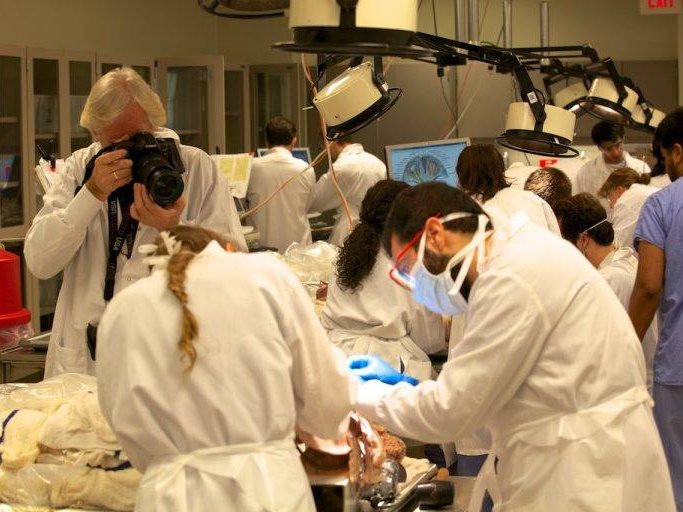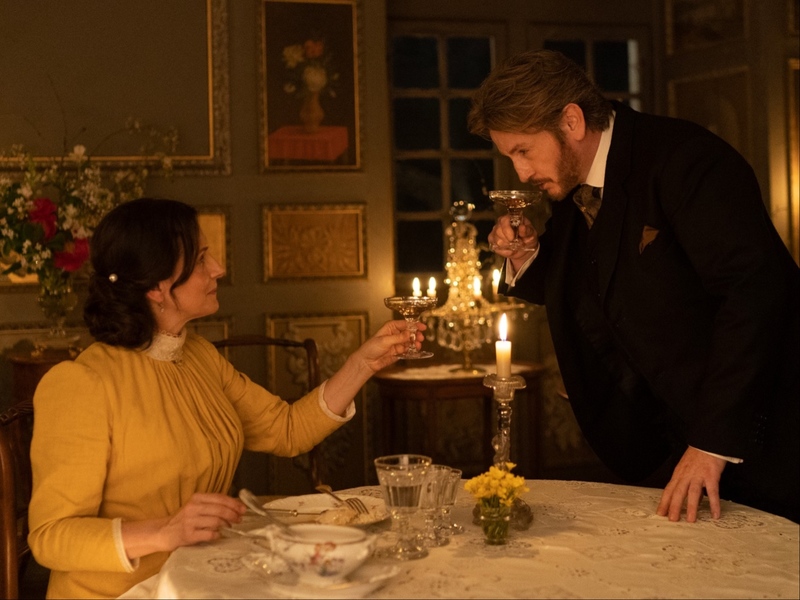Back when he was studying at the University of Wisconsin-Madison, Chip Duncan remembers tensely walking past the college’s anatomy lab, a spooky place of supposed taboo. Decades after his days of tiptoeing past the lab in school, however, he finally got a chance to cross the threshold and witness what he was afraid of all those years ago.
"I was visiting a friend in South Carolina who ran the lab in 2003, and he said, ‘Hey, why don’t you come by tomorrow and see what’s going on?’" Duncan recalled. "And I was like, really? Cadavers? And dissection? OK, but I’ll either pass out or I’ll want to make a film."
Thankfully for Duncan, and for moviegoers, it ended up being the latter, with the Milwaukee-based filmmaker premiering his new documentary, "The First Patient," at the 2018 Milwaukee Film Festival on Saturday night at 7 p.m. at the Oriental Theatre.
"What intrigued me when I first got in the room was that you very quickly move beyond the dissection into the students’ journey and what is really happening for this young person who’s obviously embraced medicine as a career," Duncan noted. "The story arc for most young students is that, first of all, they’re confronting death for the first time. Many of them. They’re overcoming their own fear – whether it’s the fear of death or the fear of touching a dead body or the fear of cutting into a dead body. Those are things that they’re confronting in a really significant way at the very beginning.
"I very quickly realized that there was a strong visual component but, much more than that, a deep and resonant story about humanity and what it means to be human taking place in that lab."
Duncan’s documentary – in his words, a kind of modern real life rendition of the 1966 Raquel Welch adventure film "Fantastic Voyage" – follows 16 young medical students as they begin studying their first patient, a lifeless cadaver, as a part of their gross anatomy class. The course is often considered a rite of passage for the future doctors, a make-or-break class that often determines if you’ll ever do hands-on work with patients or if you’ll end up elsewhere in the world of health care.
"If you asked someone if they want a doctor who practiced on a cadaver or if they want to go in cold with a surgeon who’s never worked on a cadaver, they’re going to say they want a doctor who practiced," Duncan explained. "There isn’t any way around this process at this time. It makes sense, but it’s a world we’ve never seen, a world that for the last 500-600 years has been off-limits from the public – and, in many places, taboo.
"And at the same time, they all need to learn how to touch a patient. They need to learn how to work in a team. They need to learn how to confer with colleagues and talk about the medical process and the healing process."
Still, considering the gruesome nature of the work going on inside the lab, as well as the legal rights of the donated bodies and respect for the students’ important work, it took a long time for Duncan to convince a medical school to allow his camera through its doors. (Milwaukee was one of the schools to turn him down, disappointing since "I’m tired of traveling," the director laughed.) After more than a decade of searching, however, he finally got his permission from the Mayo Clinic in Rochester, Minnesota.
"It took some courage to make the film – and it took courage for Mayo Clinic School of Medicine to agree to make the film," Duncan said. "They saw the value of this in terms of what med students are going through, but also in terms of education. They knew entertainment would be a part of it – they knew we’d be trying to make an interesting, entertaining film – but Mayo Clinic’s got a strong desire to promote medical education, both internally and externally."
After acquiring funding, Duncan and his crew went to work engraining themselves in the world of the lab and meeting the students who, just arriving in Rochester for their first semester, would soon become their stars. Of the 52 students in the class, 22 agreed to be filmed, and in the early days of the shoot, the "First Patient" crew worked to be as invisible and unobtrusive as possible, using small film technology and even still photography when regular film cameras were too big (Duncan has a full portfolio of photographs from the shoot that he’ll like to put in a gallery or exhibition sometime) and even wearing lab coats themselves so even visually they wouldn’t distract.
Soon into the shoot, however, Duncan and the crew earned the class’s trust, opening up the film to new perspectives and ideas.
"Because we didn’t know the students at the beginning, it was really difficult to say, ‘Hey, do you mind wearing a GoPro?’," Duncan recalled. "By two weeks in, they knew us and we knew them – so sure, I’ll wear it, no problem. So some of the filmmaking techniques changed as the class evolved and the more POV we could get, the better. As the film evolves, it becomes much more experiential. It’s an extraordinary journey for them and for us."
As the class went along, the dissections become more personal. Students start with the patients on their backs before eventually moving to the rest of the body, with the hands – not the face – revealing themselves to be the most difficult and emotional part of the process. And the filmmaker gained more access to the young doctors’ journey, Duncan also discovered an entirely different path for his documentary.
"Act three of the film is the part we couldn’t anticipate and didn’t really expect: watching the students learn what it means to be a human," he said. "One of the remarkable things that comes through in the film is, once the skin is removed, we are all the same. So even if you’re not remotely spiritual or religious or never entertained those ideas, when you see the film, you’re compelled to ask that question: What are we? Where did we come from?
"So, in that sense, these young students convey through the film an opportunity for everyone to look at themselves and to see the beauty of what we are and to try and comprehend the mystery."
Thanks to the startlingly human subjects at work in the film, the final version of "The First Patient" is surprisingly lively for a movie starring several dead bodies – and, maybe most important for viewers, surprisingly not gross. Part of that is that the donated bodies were embalmed, meaning there’s no blood. Part of that is Duncan’s approach, which he intentionally edited the film so the first dissection doesn’t come until the audience’s gotten comfortable with our med student protagonists and the film’s mission statement, around 20 minutes into the movie.
"You’re just getting to know the students – who they are, where they came from, what drives them, what motivates them – so that by the time you really get into the lab, you’re ready for it the same way the students are ready for it," Duncan explained.
"I’ve had a lot of people tell me, ‘Oh, I don’t know if I can watch that,’ and then they love the film. They see themselves in the lab. They see themselves on the journey. Whether they could actually use a scalpel or a saw or a chisel, who knows, but you do find a way to embrace the humanity of the cadaver and understand – by looking at the lines in their hands or the creases in their face or eyes – that this was a living, breathing human being."
For a movie surrounded by cadavers, "The First Patient" ends up being a tribute to life and those questing to protect it. And starting on Saturday night, the film will come to life on the big screen for the first time at an event in the city the film calls home. (Though the film shot in Rochester, "The First Patient" was conceived in Milwaukee, edited in Milwaukee, scored in Milwaukee and, save for one cast member, made by Milwaukeeans.) But Saturday’s screening means more than just being home for Duncan.
"(Milwaukee Film’s) created a world-class festival here. So, for us, it’s not just a chance to play the film at home; it’s a chance to play the film at a great festival."
"The First Patient" will screen at the Milwaukee Film Festival on Saturday, Oct. 20, at 7 p.m. at the Oriental Theatre. An expanded theatrical or streaming release has yet to be announced.
As much as it is a gigantic cliché to say that one has always had a passion for film, Matt Mueller has always had a passion for film. Whether it was bringing in the latest movie reviews for his first grade show-and-tell or writing film reviews for the St. Norbert College Times as a high school student, Matt is way too obsessed with movies for his own good.
When he's not writing about the latest blockbuster or talking much too glowingly about "Piranha 3D," Matt can probably be found watching literally any sport (minus cricket) or working at - get this - a local movie theater. Or watching a movie. Yeah, he's probably watching a movie.







